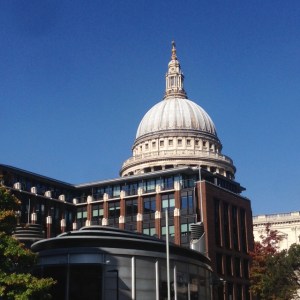
Tucked down a little alley, in the back streets of Clerkenwell is the J+A Cafe. Not just a cafe, but also a bar, J+A is a satisfying place to find, particularly if you happen to find it serendipitously. As you head down the alley, the café is on your right whereas the bar opens up on your left. The café is simply furnished, with bare brick walls adorned with a few impressionist paintings. There are plenty of seats at which to enjoy good coffee and home-made cake. Their website suggests that J+A specialise in Irish baking and so we dutifully had a slice of Guinness and chocolate cake with our coffees. Importantly, the dreaded “does it contain nuts?” question was met with a knowledgable answer and without the ‘frightened bunny face’ that I often encounter when I ask this question. J+A definitely gets a tick in the ‘cafe’s with good nut knowledge’ box on my website.
Lights were suspended from the ceiling, connected by wiring that was allowed to hang down, a section of electrical wire held at both ends and freely hanging. While I’m sure that this was done for aesthetic reasons (and certainly it works on that level), such hanging wires are in fact far more than merely pleasing to the eye. Such hanging wires were a mathematical puzzle just four centuries ago. Indeed, these simple hanging wires form curves that are so important they get their own name; they are catenary curves, from catena, the Latin for chain.

Galileo had thought that a wire hanging under its own weight and suspended at its two end points formed a parabola. A fairly simple curve that is easy to describe mathematically. It was natural for Galileo to assume that these catenary curves were really parabolic. He had earlier shown that objects that fell with gravity followed parabolic paths, and after all, the hanging wires did look almost parabolic. It fell to Joachim Jungius to show that the curve was not parabolic and then to Huygens, Bernoulli and Leibniz to derive the equations determining the form of the curve. Although the differences between the parabola and the catenary curves are subtle, they have profound consequences.
When a chain, or a wire, is suspended and allowed to hang under its own weight, it forms a catenary. Flipping this around, quite literally, a catenary arch will be self-supporting. This means that a vault made of a series of catenaries or a dome that is made into the shape of a catenary will be self-supporting with no need for buttresses. This property of the catenary curve was used by Antonio Gaudi in his designs of the Casa Mila in Barcelona and also by Christopher Wren. The famous dome of St Pauls is not a catenary, but it is not one dome either. It is in fact 3 domes stacked together. The outer dome is spherical (which is weak from a structural point of view) while the inner dome is a catenary. The dome between these two was designed, using the mathematics of the day, to support the impressive outer dome (more info here and here). Wren, was not just an architect, he was also a keen mathematician, there is maths, physics and beauty throughout many architectural designs.
Mathematics in the city reflected in the lights of J+A.
J+A is at 1+4 Sutton Lane, London EC1M 5PU



